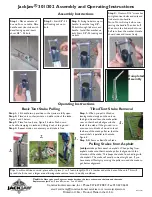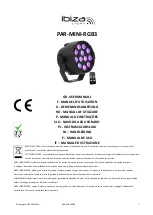
Upper
Frame Link
#5
Lower
Frame Link
Stand
Flat Washer
20mm
M20-2.5 x 175
Hex Bolt
Flat Washer
20mm
M20-2.5
Hex Nut
Flat Washer
20mm
M20-2.5
Hex Nut
Drive Pin
Frame Pin
Collar
Frame
Spacer
Frame Base
Ratchet
Swing Lever
w/Ratchet Pin
Bend Angle
Indicator
Figure 4. Frame assembly setup.
Machine Base
Concrete
Lag Screw
Lag Shield Anchor
Flat Washer
Drilled Hole
Figure 3. Proper method for anchoring a
machine to a concrete floor.
This machine and its
components are very
heavy. Get lifting help or
use power lifting equip-
ment such as a forklift to
move heavy items.
Eye injury hazard! Always
wear safety glasses when
using this machine.
-2-
Model T30860 (Mfd. Since 12/19)
The machine must be fully assembled before it
can be operated. Before beginning the assembly
process, refer to
Needed for Setup and gather
all listed items. To ensure the assembly process
goes smoothly, first clean any parts that are cov-
ered or coated in rust preventative.
Assembly
Frame Assembly Setup
1. Place frame base (see Figure 4) on stand
and verify holes are aligned.
2. Place lower frame link on top of frame base
as shown in
Figure 4 and verify both are
aligned.
3. Verify swing lever and ratchet are right side
up, and swing lever is able to rotate almost a
full 180° (see
Figure 4).
4. Insert frame spacer into swing lever and
collar, then position frame spacers between
upper and lower frame links (see
Figure 4).
Needed for Setup
Recommend Tools
Qty
Additional Person for Lifting ............................... 1
Safety Glasses (for each person) ....................... 1
Hex Wrench 4mm ............................................... 1
Open-End Wrench or Socket 20mm .................. 2
Open-End Wrench or Socket 14mm .................. 2
Cleaner/Degreaser ..............................As Needed
Disposable Shop Rags ........................As Needed
Anchoring
This machine MUST be anchored to the floor
before operating. Anchoring machinery to the
floor prevents tipping or shifting that may occur
during operation.
Lag shield anchors with lag screws (
Figure 3) are
a popular way to anchor machinery to a concrete
floor, because the anchors sit flush with the floor
surface. However, anytime local codes apply, you
MUST follow the anchoring methodology speci-
fied by the code.


























